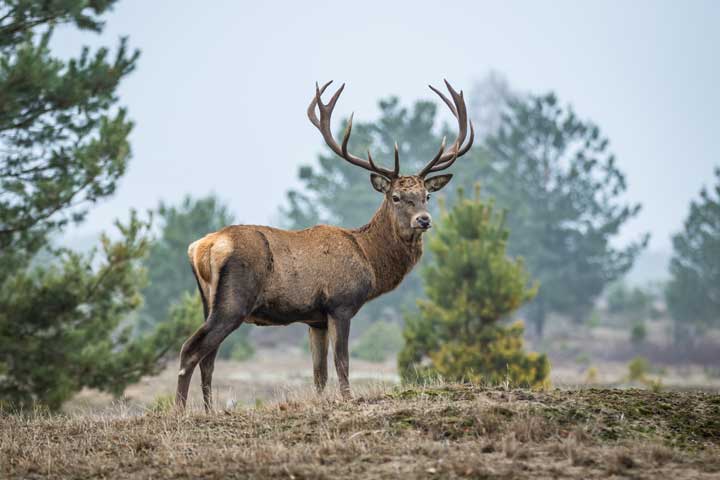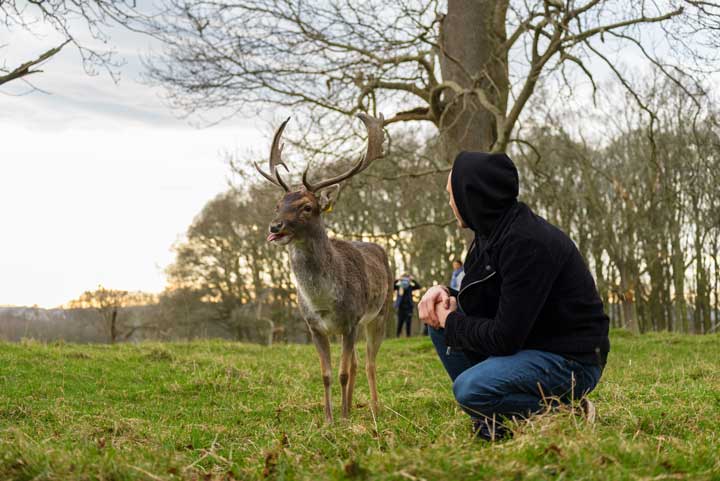Stumbling upon a white-tailed deer in the wild can be a magical experience, but if the deer becomes aggressive, you may find yourself asking, “do deer attack humans?”
Wild deer have attacked humans, but only when they feel as if their fawns or their homes are in danger. In most situations, deer run away from humans, especially female does with their fawns. Usually, the only wild deer that attack humans are bucks, and only when they are aggressively pursuing or protecting their young.
Are Deer Aggressive Towards Humans?
The simplest answer is yes: deer can be aggressive toward any creature that invades its space at the wrong time. If you are near an aggressive deer, you will know. When deer become aggressive, they show a few specific behaviors that include grunting and crouching.
The deer grunt sounds like an explosion of air they push out of their mouths. As they grunt, they get into a crouch with flexed legs. So the deer will look even more aggressive, its hair stands on end. A buck with antlers will point its head toward the creature it is attacking. Deer will also use their hooves while standing on their hind legs to knock down an opponent.

Considering that adult bucks stand about six feet tall and weigh over 200 pounds, humans will struggle to overcome an attacking deer. Antlered deer have built-in weapons making them incredibly dangerous cornered animals. A bizarre-acting buck can be deadly to humans or other animals it attacks.
Knowing when deers start to shed their antlers can make hiking safer in the long run.
Do Deer Ever Attack Humans?
Deer have attacked humans. Although occurrences are rare, they are increasing in frequency. If you are in a position where a deer looks like it will attack, you should prepare yourself to fend off the deer. Use a nearby object, like a stick or your backpack, to protect yourself from the deer attack. A bizarre-acting buck might stay away from you if you put something between yourself and it.
If you have a chance to escape, do it. Deer cannot climb trees or open doors, so if you can get into a safe space, do it. In the unlikely event that a deer does attack and knock you to the ground, lay in a fetal position and protect your head and neck. Eventually, the deer will realize you aren’t a threat, but it might aggressively stomp on you until it gets bored.
In the worst-case scenario where an aggressive buck continues to attack, grab its antlers and hold on. It cannot stomp on you if you hold tightly to the antlers. But, when you let go, be ready to run if the deer approaches as it could start attacking again.
Are Deer Friendly to Humans?

Deer and humans can interact in a friendly manner, but like attacks, friendships are rare. Occasionally, humans who have found orphaned fawns raise them as pets. Since the deer grows up with the human, it becomes a pet rather than a wild animal. To protect a pet deer from hunters, put an orange collar on it.
Adult deer tend not to become friendly with humans. Instead, deer avoid humans. Even if you see deer in the city, do not expect them to be tame deer, as they are still considered wild animals. Similar to feeding moose in the wild, feeding a deer can be dangerous for the deer as it can learn to trust humans when many want to shoot them.
Can Deer Be Aggressive?
Deer can be dangerously aggressive, especially if the deer is an adult buck during mating season. The territorial animals can attack humans and other animals if they interfere with mating, food, or fawns. If they live near your home or farm, they can wreak havoc by eating your plants and relieving themselves on your landscaping or gardens.
Generally, deer are aggressive twice a year. The first is when fawns stay near their parents. Deer will attack anything that comes near their precious babies. Do not go near fawns between early spring to early summer. Never assume a lone fawn is an orphan, as a potentially aggressive deer is most likely nearby and ready to attack if the need arises.
You should also stay far away from bucks during the late fall to early winter months when they are looking to mate. All they want to do is fight other bucks and breed with female deer. They have one goal during mating season, and anything that gets in the way could get hurt. Attacks by bucks increase during mating season.
When deer become aggressive, they show a few signs. First is the grunt and a hoof stomp to let the invader know the deer sees it. They also swivel their ears toward potentially dangerous sounds, and they sniff the air in an attempt to decode the scent in most attacks on humans.
Are Deer Afraid of Dogs?
Like the other questions on this list, the simplest answer is mixed. Deer will attack dogs if the dogs are a threat to the deer’s territory. But, in some cases, deer will stay away from dogs.
The most common time for deer to attack dogs is during the early spring and summer when deer are protecting their young. Like other cornered animals, they feel threatened by dogs in a dangerous scenario. Antlered deer are especially dangerous for domesticated dogs, as many deer attack dogs all over the country.
If dogs get too close to fawns, mother deer will attack. Deer will also attack if a dog blocks the deer’s regular food source. Otherwise, deer tend to stay away from most creatures, including dogs and humans. Many local newspapers have covered deer attack dogs stories, as most people are shocked by the occurrence.
What Does It Mean When a Deer Bobs Its Head?
Deer have a 300-degree view, but they do have depth perception. If a deer needs to get a better look at something, including a person or a dog, they will bog their heads. Generally, deer bob their heads when they need to determine if something is a threat. They often adjust their ear posture when they feel threatened, too.
If you notice a deer bobbing its head near you, standstill. Deer tend to perceive moving objects as potential threats. When the deer no longer sees you as a threat, it will move its tail and wander away. Otherwise, if a deer exhibits aggressive behavior and the deer approaches you, get away as quickly as possible or stand perfectly still.
What to Do if a Deer Attacks You?
No one expects a deer attack, but if it happens, you should be prepared. With so many homes and businesses in former deer territory, the generally docile animals can react aggressively. If you feel like a deer is ready to attack you, get away from it as fast as possible. Deer are large animals, often weighing over 200 pounds (90kg), so they can hurt you. Antlered deer can be especially dangerous.
Unfortunately, many deer attacks happen in areas that offer little protection. If you cannot get into a house or car, climb a tree. Unfortunately, not all trees have climbable branches, so you should also prepare yourself for an inevitable attack. Lay in a fetal position and protect your head and vital organs. Eventually, the deer will see you aren’t a threat.
How Do You Avoid a Deer Attack?
Generally, the safest way to avoid an aggressive deer is to stay away from it. Rather than putting yourself in danger, you need to have an escape route that gets you as far from the deer as possible. Knowing some basic facts about deer, such as when they sleep, how fast they move, or if they are active in the wind or rain, can be useful.
They might look sweet and docile, but they can run quickly and attack painfully. Your goal is to take cover so the deer cannot hit you with its antlers or stomp on you with its hooves. Even if you try to feed a docile deer, it can feel threatened, rise up on its hind legs, and attack you with the front ones.
Rut bucks and mothering does can also become extremely aggressive with a hint of danger. If you try to get close to a fawn, know that the mother will interfere and drive you off. Rutting bucks will attack anything that gets too close and isn’t a doe. When deer become a problem near your home, your best bet is to call local wildlife authorities for advice and assistance.
Deer are lovely animals, but you are better off observing them from a distance. Don’t get too close to them unless you have an unfailing escape route or a license to hunt.
Deer are generally docile creatures that want nothing to do with humans or their pets. Deer want to be left alone so they can eat, raise their fawns, and make more babies. Unfortunately, humans built homes and farms too close to deer territory, so they end up attacking when they feel threatened. Deer attacks aren’t as dangerous as bear attacks, but one could hurt you.





thanks this have been very helpful
My neighbor was attacked by a doe with no fawns. When reported to wildlife fish and games, they seemed minimally concerned. If this behavior is more common with deer, shouldn’t there be a record kept when someone is attacked to see if it’s on the rise?